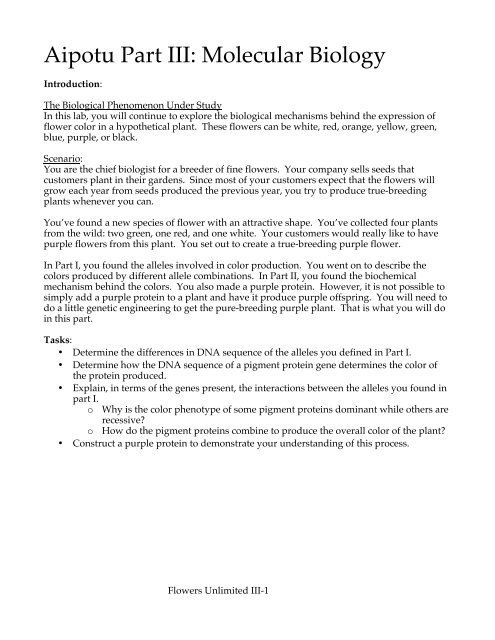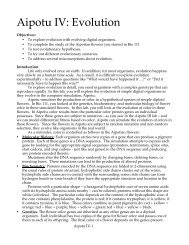Molecular Biology Lab Manual in .pdf format - Aipotu
Molecular Biology Lab Manual in .pdf format - Aipotu
Molecular Biology Lab Manual in .pdf format - Aipotu
You also want an ePaper? Increase the reach of your titles
YUMPU automatically turns print PDFs into web optimized ePapers that Google loves.
Eukaryotic genes, like those found <strong>in</strong> our simulated organisms, have promoters andterm<strong>in</strong>ators for controll<strong>in</strong>g transcription as well as start and stop codons for controll<strong>in</strong>gtranslation. Although the promoter and term<strong>in</strong>ator sequences are different <strong>in</strong> differentorganisms, the genetic code, <strong>in</strong>clud<strong>in</strong>g the start and stop codons is identical <strong>in</strong> all organisms.The promoter and term<strong>in</strong>ator sequences used <strong>in</strong> the hypothetical organism simulated by thetool are shown below:a promoter:a term<strong>in</strong>ator:5’-TATAA-3’5’-GGGGG-3’||||| |||||3’-ATATT-5’3’-CCCCC-5’*Transcription beg<strong>in</strong>s with the*Transcription ends with thefirst base-pair to the right offirst base-pair to the left ofthis sequence and proceeds to thethis sequence.right.therefore, a gene would look like this:5’-TATAAXXXXXXXXXXXXXXXXXXXXXXXXXXXXXGGGGG-3’|||||||||||||||||||||||||||||||||||||||3’-ATATTXXXXXXXXXXXXXXXXXXXXXXXXXXXXXCCCCC-5’*the region shown as X’s would be transcribed <strong>in</strong>to pre-mRNA.In addition, eukaryotic genes have a few features that prokaryotic genes do not have. Theseare:• transcription produces an mRNA called a pre-mRNA which is not yet ready fortranslation.• this pre-mRNA is then processed <strong>in</strong> several steps:o The <strong>in</strong>trons are removed and the exons are jo<strong>in</strong>ed; this is called mRNA“splic<strong>in</strong>g”. This is controlled by splice signal sequences. In real organisms, thesesequences are not well known. In general, <strong>in</strong>trons start with 5’-GU-3’ and endwith 5’-AG-3’. In the hypothetical organism, <strong>in</strong>trons start with 5’-GUGCG-3’ andend with 5’-CAAAG-3’.o a modified G nucleotide is added to the 5’ end of the mRNA; this is called the“cap”. This is not shown.o many A’s are added to the 3’ end of the mRNA; this is called the tail. In realorganisms, as many as 400 A’s can be added at a specific signal sequence; the tooladds 13 A’s as a tail to the 3’ end of any mRNA. Note that these A’s do notcorrespond to T’s <strong>in</strong> the DNA.In previous labs, you did the work by hand; this was necessary <strong>in</strong> order to make the processesclear to you. Now that you understand how these processes work, the tool will do all thetedious work of:• f<strong>in</strong>d<strong>in</strong>g the promoter and term<strong>in</strong>ator• read<strong>in</strong>g the DNA sequence to produce the pre-mRNA• f<strong>in</strong>d<strong>in</strong>g the splice sites• splic<strong>in</strong>g and tail<strong>in</strong>g the mRNA• f<strong>in</strong>d<strong>in</strong>g the start codon• translat<strong>in</strong>g the mRNAFlowers Unlimited III-3
The tool will then allow you to make specific mutations <strong>in</strong> a gene sequence and it will thencalculate and display their effects on the mRNA and prote<strong>in</strong>. You do not have to deal with allthe details listed above; the software will take care of it all. Researchers use tools like this toanalyze the genes they are study<strong>in</strong>g.There are three k<strong>in</strong>ds of experiments you can perform with this tool. The follow<strong>in</strong>g sectionsuse examples to show you how to do each; you will need to devise your own experiments tocarry out the tasks above.I) Exam<strong>in</strong>e the Pigment Prote<strong>in</strong> Genes Present <strong>in</strong> an Organism from the Greenhouse. This simulatessequenc<strong>in</strong>g the DNA from the two pigment prote<strong>in</strong>s genes that an organism possesses,express<strong>in</strong>g them, and display<strong>in</strong>g their colors.1) Double-click on the Green-2 organism <strong>in</strong> the Greenhouse. You should see this:The Green-2 organism conta<strong>in</strong>s two alleles of the pigment prote<strong>in</strong> gene. Each of these alleleshas a dist<strong>in</strong>ct DNA sequence. One of these sequences is shown <strong>in</strong> the Upper Gene W<strong>in</strong>dow; itis a blue-colored prote<strong>in</strong> as shown by the blue square next to the “Color:” label. The otherprote<strong>in</strong> is shown <strong>in</strong> the Lower Gene W<strong>in</strong>dow; this is a yellow-colored prote<strong>in</strong>. The comb<strong>in</strong>edcolor of the two prote<strong>in</strong>s is green as shown by the Comb<strong>in</strong>ed Color <strong>in</strong> between the two GeneW<strong>in</strong>dows.IMPORTANT NOTE:This software is under development. Please treat it gently and be patient. Please report anybugs to your TA. You should save your Greenhouse regularly, especially if you save a largenumber of organisms.Flowers Unlimited III-4
The Gene W<strong>in</strong>dows also show the key features of the genes:• Click<strong>in</strong>g on a base <strong>in</strong> the upper DNA strand highlights the correspond<strong>in</strong>g bases <strong>in</strong> themRNA and the correspond<strong>in</strong>g am<strong>in</strong>o acid <strong>in</strong> the prote<strong>in</strong> (as appropriate).• In the DNA sequence:o Promoters are shown <strong>in</strong> greeno Term<strong>in</strong>ators are shown <strong>in</strong> red• In the pre-mRNA sequence:o Exons are shown <strong>in</strong> coloro Introns are not colored• In the mature mRNA sequence:o Exons are colored as <strong>in</strong> the pre-mRNAo Start and stop codons are underl<strong>in</strong>edThe Gene W<strong>in</strong>dows work like the Gene Explorer with the addition of colors.II) Compare the DNA sequences of two pigment prote<strong>in</strong> genes. You can compare the DNA sequenceof the two genes by click<strong>in</strong>g on the “Compare” menu and choos<strong>in</strong>g “Upper vs. Lower”. Aw<strong>in</strong>dow will appear show<strong>in</strong>g the differences between the two sequences.III) Edit a DNA Sequence or Create a New DNA Sequence and Determ<strong>in</strong>e the Result<strong>in</strong>g Prote<strong>in</strong>’sAm<strong>in</strong>o Acid Sequence and Color. You can edit the sequence <strong>in</strong> either of the Gene W<strong>in</strong>dows andclick the “Fold” button to predict the color of the prote<strong>in</strong>. The tool will also give the color thatresults from the comb<strong>in</strong>ation of the colors <strong>in</strong> the Upper and Lower w<strong>in</strong>dows.You can edit the DNA <strong>in</strong> several ways:• To delete the selected base, use the “delete” key.• To replace the selected base with another base, type a lower-case letter (a, g, c, or t).• To <strong>in</strong>sert bases to the left of the selected base, type an upper-case letter (A, G, C, or T).• You can enter an entirely new (or copied) DNA sequence by click<strong>in</strong>g the “Enter NewDNA Sequence” button.For example:1) Double-click the Red organism <strong>in</strong> the Greenhouse.2) In the Upper Gene W<strong>in</strong>dow, click on the top DNA strand near base 20. The base youhave clicked on will be highlighted <strong>in</strong> blue. In addition:• the correspond<strong>in</strong>g bases <strong>in</strong> the mRNAs and the correspond<strong>in</strong>g am<strong>in</strong>o acid <strong>in</strong>the prote<strong>in</strong> will be selected.• at the bottom of the Upper Gene W<strong>in</strong>dow, you will see “Selected Base = 20”or some similar number correspond<strong>in</strong>g to the base you selected.If you have not selected base 20, use the arrow keys to select it.3) Type “C”. This will change base 20 from G to C, thus remov<strong>in</strong>g the start codon forthe gene. You will immediately see that the prote<strong>in</strong> sequence shown under themRNA sequence, now reads “none” <strong>in</strong>dicat<strong>in</strong>g that no prote<strong>in</strong> will be made fromthis gene. Furthermore, the border of the Upper Gene W<strong>in</strong>dow will turn p<strong>in</strong>k to<strong>in</strong>dicate that the new prote<strong>in</strong> has not been folded.Flowers Unlimited III-5
Specific Tasks for this sectiona) What are the differences <strong>in</strong> the DNA sequences of the alleles you def<strong>in</strong>ed <strong>in</strong> Part I.b) Do all the white alleles have the same DNA sequence? H<strong>in</strong>t: use the Compare menu tocompare the sequences.c) Which DNA sequences are found <strong>in</strong> each of the four start<strong>in</strong>g organisms?d) Us<strong>in</strong>g this knowledge, construct a pure-breed<strong>in</strong>g purple organism.e) Advanced tasks: How does the DNA sequence of the different alleles expla<strong>in</strong> the effectsof mutations you found <strong>in</strong> part I?f) Try mak<strong>in</strong>g this prote<strong>in</strong>: MLVKEIAMYRFATHER (“M LVKE I AM YR FATHER” thanks toGrier Belter and Griff<strong>in</strong> Hancock from the Nova Classical Academy)You should put your data <strong>in</strong> the tables below:(a) and (b)allele color change(s) <strong>in</strong> am<strong>in</strong>o acid sequence change(s) <strong>in</strong> DNA sequenceAre all the white alleles the same?Flowers Unlimited III-7
(c)Green-1Green-2RedWhite(d) Show your TA that you have made a pure-breed<strong>in</strong>g purple organism. For full credit, youneed to expla<strong>in</strong> to your TA why it is purple and pure-breed<strong>in</strong>g.Flowers Unlimited III-8
<strong>Lab</strong> Report• This report is due <strong>in</strong> class today; you can write it us<strong>in</strong>g Microsoft Word on the lab macsand then pr<strong>in</strong>t it on the lab pr<strong>in</strong>ter.• This is a group project for a group grade.• Although you worked together as a class, your report must be <strong>in</strong> your own words.Your lab report must consist of answers to the follow<strong>in</strong>g questions:Us<strong>in</strong>g the tools <strong>in</strong> the Genetics Workbench, make random mutants of one of the start<strong>in</strong>gorganisms <strong>in</strong> the Greenhouse. Select one with a color not found <strong>in</strong> the orig<strong>in</strong>al Greenhouseorganisms and save it to the Greenhouse.In your lab report, you will use what you have learned <strong>in</strong> the three <strong>Aipotu</strong> labs to provide acomplete explanation of why your mutant has the color it does. Specifically, you must answerthe follow<strong>in</strong>g questions as they apply to the mutant you created. An example is given <strong>in</strong> italics;your answer should be similar, but more thoroughly expla<strong>in</strong>ed.1) Start<strong>in</strong>g Organism. Which organism from the Greenhouse did you start with? For example,“We started with Green-1”2) Result<strong>in</strong>g Color. What was the color of your mutant organism? For example, “We found ablack mutant of Green-1”3) <strong>Molecular</strong> <strong>Biology</strong>. Your mutant stra<strong>in</strong> conta<strong>in</strong>s two alleles of the pigment prote<strong>in</strong> gene.For each allele, describe the change(s) <strong>in</strong> DNA when compared to the un-mutated start<strong>in</strong>gsequences found <strong>in</strong> the organism you listed <strong>in</strong> (1). Then describe how each of these changes tothe DNA sequence led to the result<strong>in</strong>g changes <strong>in</strong> prote<strong>in</strong> sequence. For example, “In the topallele, C47 had been mutated to G; this changed Arg17 to Glutamic acid. In the bottom allele, T12 hadbeen deleted; this <strong>in</strong>activated the promoter, result<strong>in</strong>g <strong>in</strong> no mRNA or prote<strong>in</strong> be<strong>in</strong>g made.”4) Biochemistry. Your mutant stra<strong>in</strong> produces one or more copies of the pigment prote<strong>in</strong>. Foreach, describe how the changes <strong>in</strong> am<strong>in</strong>o acid sequence you described <strong>in</strong> (3) result <strong>in</strong> the colorof each allele. For example, “The top allele produced a black prote<strong>in</strong> because...... S<strong>in</strong>ce the bottomallele produced no prote<strong>in</strong>, it’s contribution was colorless.”5) Genetics. Expla<strong>in</strong> why the two alleles you have described <strong>in</strong> (3) and (4) comb<strong>in</strong>e to formthe color they do. For example, “From our previous work, color is always dom<strong>in</strong>ant to colorless.From above, the genotype of our stra<strong>in</strong> is black/white. Therefore, it will be black.”You should e-mail the Word file to your TA and cc to brian.white@umb.eduFlowers Unlimited III-9
The Genetic Code <strong>in</strong> mRNAU UUU pheUUC pheUUA leuUUG leuC CUU leuCUC leuCUA leuCUG leuA AUU ileAUC ileAUA ileAUG metG GUU valGUC valGUA valGUG valU C A GUCU ser UAU tyrUCC ser UAC tyrUCA ser UAA STOPUCG ser UAG STOPCCU proCCC proCCA proCCG proACU thrACC thrACA thrACG thrGCU alaGCC alaGCA alaGCG alaCAU hisCAC hisCAA glnCAG glnAAU asnAAC asnAAA lysAAG lysGAU aspGAC aspGAA gluGAG gluUGU cysUGC cysUGA STOPUGG trpCGU argCGC argCGA argCGG argAGU serAGC serAGA argAGG argGGU glyGGC glyGGA glyGGG glyUCAGUCAGUCAGUCAGFlowers Unlimited III-10



